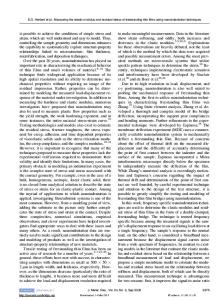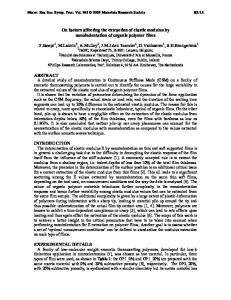Determination of Elastic Modulus and Yield Stress of Ultra-thin Cu and low-k Films Using Spherical Nanoindentation Measu
- PDF / 1,889,023 Bytes
- 6 Pages / 595 x 842 pts (A4) Page_size
- 11 Downloads / 343 Views
B8.15.1
Determination of elastic modulus and yield stress of ultra-thin Cu and low-k films using spherical nanoindentation measurement Satoshi Shimizu, Nobuo Kojima, and Jiping Ye Research Department, NISSAN ARC, LTD., 1 Natushima-cho, Yokosuka 237-0061, Japan ABSTRACT A spherical nanoindentation method was developed to evaluate elastic and plastic deformation parameters. The experimental reliability was confirmed by examining fused silica in the elastic deformation range. Yield stress as a quantitative plastic parameter was estimated using the Hertz contact theory and Tresca yield criterion. A copper thin film and two types of low-k thin film were examined. Reduced modulus was almost the same as the value obtained for the Cu (100) plane and yield stress was found to be between single crystals Cu (111) and Cu (100). These mechanical properties were thought to be dependent on the crystal orientation of the copper thin film. The two types of MSQ low-k film exhibited a difference in yield stress, although hardness was estimated to be similar by using the conventional nanoindentation method. These results have never been seen on a micro-mater scale. INTRODUCTION Quantitative nanometer-scale estimations of mechanical properties are important in the development of multilevel interconnect technology for ultra-large-scale integrated circuits. Recently, a convenient nanoindentation measurement technique based on Oliver’s method [1] has been widely used for evaluating the hardness and reduced modulus of thin films. This technique has some limitations in estimating elastic properties and yield stress due to initial plastic deformation. Although these properties are indispensable to determine mechanical strength of multilevel interconnect structures, up to now, for example, macro-meter-scale mechanical data obtained from bulk materials have still been applied in computer simulations for estimating stress distributions on a nanometer scale. In the past studies, spherical indentation method using the Hertz contact theory was suggested to evaluate mechanical properties of near surface materials [2, 3]. However the estimation area for this method was much larger than several micrometers. For quantitative estimation of mechanical properties of ultra thin film, in our recent studies, we successfully developed a novel spherical nanoindentation method for determining the yield stress of tribofilms on a nanometer scale [4]. In this study, we applied this spherical nanoindentation method to evaluate the modulus in the elastic deformation range and the yield stress from initial plastic deformation. The mechanical parameter results were examined from the view of difference in the physical/chemical properties for copper and low-k thin films. EXPERIMENTAL PROCEDURE The nano-indentation test was performed using the TriboIndenterTM (Hysitron, Inc., Minneapolis, MN) with the capability of measuring load-depth curves with 1 nN load resolution and 0.2 nm displacement control. First, fused silica was selected as a standard material of spherical n
Data Loading...











